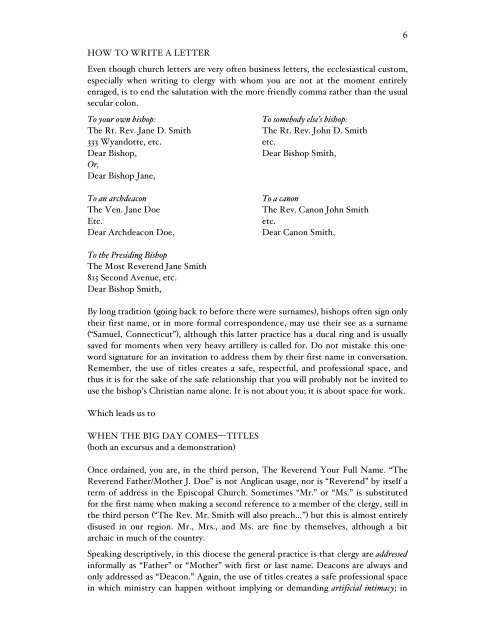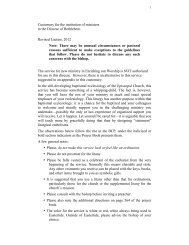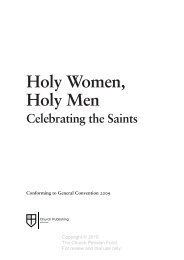Bishop Paul's Guide for Postulants - Diocese of Bethlehem
Bishop Paul's Guide for Postulants - Diocese of Bethlehem
Bishop Paul's Guide for Postulants - Diocese of Bethlehem
You also want an ePaper? Increase the reach of your titles
YUMPU automatically turns print PDFs into web optimized ePapers that Google loves.
6<br />
HOW TO WRITE A LETTER<br />
Even though church letters are very <strong>of</strong>ten business letters, the ecclesiastical custom,<br />
especially when writing to clergy with whom you are not at the moment entirely<br />
enraged, is to end the salutation with the more friendly comma rather than the usual<br />
secular colon.<br />
To your own bishop:<br />
To somebody else’s bishop:<br />
The Rt. Rev. Jane D. Smith<br />
The Rt. Rev. John D. Smith<br />
333 Wyandotte, etc. etc.<br />
Dear <strong>Bishop</strong>,<br />
Dear <strong>Bishop</strong> Smith,<br />
Or,<br />
Dear <strong>Bishop</strong> Jane,<br />
To an archdeacon<br />
The Ven. Jane Doe<br />
Etc.<br />
Dear Archdeacon Doe,<br />
To a canon<br />
The Rev. Canon John Smith<br />
etc.<br />
Dear Canon Smith,<br />
To the Presiding <strong>Bishop</strong><br />
The Most Reverend Jane Smith<br />
815 Second Avenue, etc.<br />
Dear <strong>Bishop</strong> Smith,<br />
By long tradition going back to be<strong>for</strong>e there were surnames, bishops <strong>of</strong>ten sign only<br />
their first name, or in more <strong>for</strong>mal correspondence, may use their see as a surname<br />
“Samuel, Connecticut”, although this latter practice has a ducal ring and is usually<br />
saved <strong>for</strong> moments when very heavy artillery is called <strong>for</strong>. Do not mistake this one<br />
word signature <strong>for</strong> an invitation to address them by their first name in conversation.<br />
Remember, the use <strong>of</strong> titles creates a safe, respectful, and pr<strong>of</strong>essional space, and<br />
thus it is <strong>for</strong> the sake <strong>of</strong> the safe relationship that you will probably not be invited to<br />
use the bishop’s Christian name alone. It is not about you; it is about space <strong>for</strong> work.<br />
Which leads us to<br />
WHEN THE BIG DAY COMESTITLES<br />
both an excursus and a demonstration<br />
Once ordained, you are, in the third person, The Reverend Your Full Name. “The<br />
Reverend Father/Mother J. Doe” is not Anglican usage, nor is “Reverend” by itself a<br />
term <strong>of</strong> address in the Episcopal Church. Sometimes “Mr.” or “Ms.” is substituted<br />
<strong>for</strong> the first name when making a second reference to a member <strong>of</strong> the clergy, still in<br />
the third person “The Rev. Mr. Smith will also preach…” but this is almost entirely<br />
disused in our region. Mr., Mrs., and Ms. are fine by themselves, although a bit<br />
archaic in much <strong>of</strong> the country.<br />
Speaking descriptively, in this diocese the general practice is that clergy are addressed<br />
in<strong>for</strong>mally as “Father” or “Mother” with first or last name. Deacons are always and<br />
only addressed as “Deacon.” Again, the use <strong>of</strong> titles creates a safe pr<strong>of</strong>essional space<br />
in which ministry can happen without implying or demanding artificial intimacy; in





![Bishop Paul V. Marshall Nearly 16 years A biographical sketch [long]](https://img.yumpu.com/33803943/1/190x245/bishop-paul-v-marshall-nearly-16-years-a-biographical-sketch-long.jpg?quality=85)


